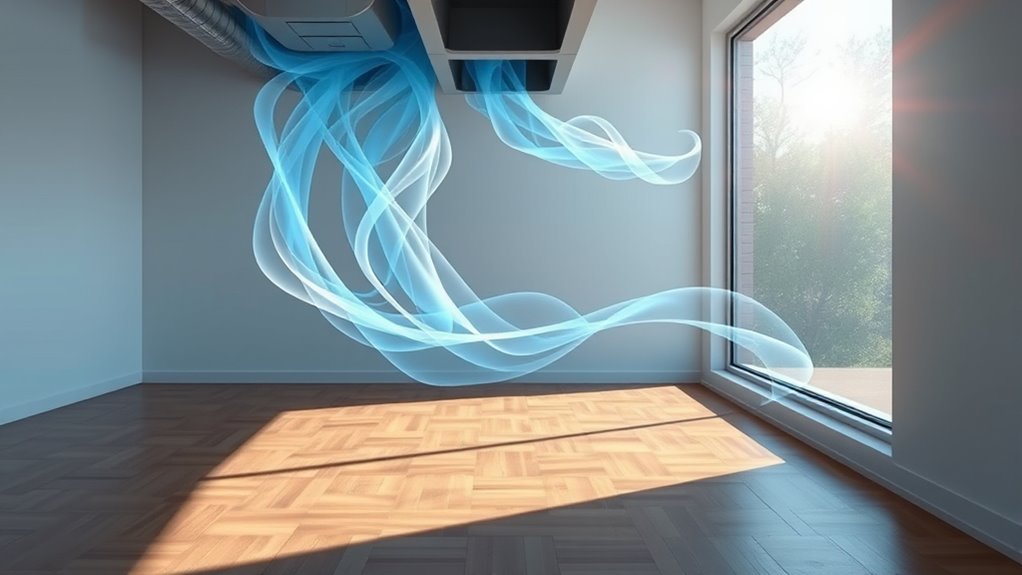Cold air diffusion works by controlling how cold air moves and spreads evenly throughout a space, guided by principles of thermodynamics and airflow. Cold air naturally sinks due to density differences, while airflow patterns and pressure differences influence its path. Factors like humidity, obstacles, and equipment placement also impact how effectively cold air disperses. If you keep exploring, you’ll discover how these scientific concepts come together to optimize cooling and safety in various environments.
Key Takeaways
- Cold air naturally moves downward due to higher density, promoting even distribution throughout a space.
- Diffusion disperses cold air by molecular motion, aiming for uniform temperature and preventing hot or cold spots.
- Thermodynamic principles govern heat transfer, allowing cold air to displace warmer air and reach thermal equilibrium.
- Proper airflow and vent placement optimize diffusion, ensuring efficient temperature control and preventing localized cooling.
- Controlling diffusion rate and managing environmental factors improve energy efficiency and maintain safe, consistent indoor temperatures.
What Is Cold Air Diffusion?

Cold air diffusion is a process that involves spreading cold air evenly throughout a space to achieve uniform temperature and improve air quality. You control how quickly the cold air disperses by adjusting the diffusion rate, which influences the overall effectiveness of cooling. When cold air is introduced, the goal is to lower the air temperature evenly, preventing hot spots or uneven cooling. A higher diffusion rate means the cold air mixes faster with the existing air, leading to quicker temperature stabilization. Conversely, a slower diffusion rate results in gradual cooling, which can be more energy-efficient. Understanding how diffusion rate impacts air temperature helps you optimize the process for comfort, efficiency, and air quality. It’s a fundamental aspect of cold air diffusion‘s effectiveness in various environments. Additionally, the use of proper airflow management techniques can further enhance the uniform distribution of cold air.
The Role of Thermodynamics in Cold Air Movement

Understanding how cold air moves through a space requires an appreciation of thermodynamics, the branch of physics that explains energy transfer and heat behavior. Cold air naturally seeks thermal equilibrium, where temperatures balance out. Heat transfer occurs from warmer to cooler areas, driving the movement of cold air as it displaces warmer air. Additionally, the thermal properties of the environment influence how quickly and efficiently cold air disperses. | Heat Transfer Mode | Effect on Cold Air | Result | |———————|———————|——————————–| | Conduction | Transfers heat directly through contact | Cold air cools nearby surfaces | | Convection | Moves heat via fluid motion | Cold air sinks, warm rises | | Radiation | Transfers heat through electromagnetic waves | Less influential in air movement | This process ensures cold air spreads efficiently, seeking balance and stabilizing the environment.
How Airflow Patterns Influence Cold Air Distribution

Airflow patterns play a essential role in determining how cold air is distributed throughout a space. When cold air enters a room, it doesn’t spread evenly; instead, airflow vortices develop, creating circular motion that influences distribution. These vortices can trap cold air in certain areas or push it toward others, affecting comfort and efficiency. Pressure differentials between different zones cause air to move along specific paths, shaping the overall airflow pattern. By understanding how these pressure differences and vortices interact, you can optimize ventilation and cooling strategies. Proper placement of vents and fans encourages desired airflow patterns, helping cold air reach every corner. Recognizing these dynamics allows you to control temperature more effectively and improve energy efficiency in your space. Additionally, implementing strategic vent placement can help manage vortex formation and enhance overall airflow distribution.
The Process of Diffusion in Gases

You can observe that gas molecules move randomly, constantly bouncing and changing direction. This movement causes molecules to spread out from areas of high concentration to low, driven by concentration differences. Understanding these processes helps explain how cold air disperses throughout a space.
A) Random Movement of Molecules
Molecules in a gas move randomly, constantly bouncing off each other and the container walls. This molecular randomness means each particle travels in unpredictable directions, creating a chaotic yet steady motion. As molecules collide, they transfer energy, maintaining the overall temperature. This incessant energy transfer ensures molecules keep moving at different speeds, fueling the diffusion process. To understand this better, consider the following table:
| Molecule Behavior | Impact on Diffusion |
|---|---|
| Random movement | Ensures molecules spread evenly |
| Collisions | Facilitate energy transfer |
| Unpredictable paths | Maintain molecular chaos |
| Speed variations | Drive diffusion rates |
| Energy exchange | Keeps molecules active |
This randomness is fundamental to how gases reach equilibrium, making diffusion possible through relentless molecular motion.
B) Concentration Gradient Effects
When a gas has different concentrations in separate areas, molecules naturally move from regions of higher concentration to those with lower concentration. This movement is driven by the concentration gradient, which creates pressure differences that push molecules toward equilibrium. As molecules diffuse, they undergo frequent molecular collisions, which help distribute kinetic energy uniformly and facilitate their spread. The greater the concentration difference, the more pressure difference exists, speeding up diffusion. Over time, molecular collisions slow the process as the concentrations balance out. You’ll notice this in cold air diffusion, where molecules move from warmer, denser regions to cooler, less dense areas, driven by pressure differences. This natural process continues until a uniform concentration is achieved, resulting in an even distribution of molecules throughout the space. Additionally, the types of alimony awarded can influence the overall dynamics of post-divorce financial stability.
Factors That Affect Cold Air Dispersion

Several factors influence how cold air disperses in a given environment, affecting both its speed and pattern of movement. Air pressure plays a key role; higher pressure areas tend to push cold air more forcefully, leading to faster dispersion, while lower pressure allows cold air to settle and spread slowly. Humidity levels also matter—when humidity is high, moisture in the air can slow down cold air movement because water molecules create resistance. Conversely, dry air allows cold air to flow more freely and quickly. Additionally, temperature differences, obstacles, and airflow currents impact dispersion patterns. The presence of nearby water parks can also influence local humidity and airflow, thereby affecting how cold air disperses in the area. Understanding these factors helps you predict how cold air will behave in different settings, allowing for better control and utilization of cold air diffusion.
Practical Applications of Cold Air Diffusion

Cold air diffusion has practical applications across various industries, helping to improve efficiency, safety, and comfort. In climate control, it’s used to evenly distribute cooled or heated air, preventing hot or cold spots and maintaining consistent indoor comfort. HVAC systems rely on cold air diffusion to optimize airflow, reducing energy consumption and enhancing overall efficiency. In commercial spaces, proper cold air diffusion improves indoor air quality and prevents moisture buildup that could lead to mold. It also plays a role in safety by controlling temperature in sensitive environments, such as data centers or laboratories. Additionally, jet boat technology exemplifies the importance of efficient propulsion systems in navigating shallow waters and enhancing maneuverability. By understanding and applying cold air diffusion principles, you can better regulate indoor climates, create more comfortable spaces, and ensure equipment operates within safe temperature ranges.
Frequently Asked Questions
How Does Humidity Affect Cold Air Diffusion?
Humidity levels substantially influence cold air diffusion because water vapor in the air affects how cold air spreads. When humidity is high, water vapor traps heat and slows down diffusion, making it less effective. Conversely, low humidity allows cold air to diffuse more quickly and evenly, as less water vapor is present to hinder the process. So, understanding humidity levels helps you manage and optimize cold air diffusion more effectively.
Can Cold Air Diffusion Be Controlled or Enhanced Artificially?
You can control or enhance cold air diffusion by adjusting airflow patterns and temperature gradients. Use fans or vents to direct airflow precisely, creating consistent airflow patterns that improve diffusion. Additionally, manipulating temperature gradients—such as pre-cooling spaces or using insulation—can optimize how cold air spreads. These methods allow you to better manage cold air distribution, making it more efficient and effective for your specific needs.
What Are the Environmental Impacts of Cold Air Diffusion?
Imagine you’re in the 21st century, where cold air diffusion impacts urban planning. You might not realize it, but it affects air quality, energy efficiency, and local ecosystems. Cold air diffusion can reduce urban heat islands, saving energy, but excessive or poorly managed use may lead to unintended environmental consequences. By thoughtfully integrating it into city designs, you help balance climate benefits with ecological sustainability, making your city both cooler and greener.
How Does Surface Temperature Influence Gas Diffusion Rates?
You’ll find that higher surface temperatures increase gas diffusion rates because thermal conductivity rises, enabling faster heat transfer. This warming enhances molecular movement, making molecules spread out more quickly. Conversely, cooler surfaces slow down diffusion by reducing thermal conductivity and limiting molecular activity. So, when the surface temperature is warmer, gases diffuse faster due to increased molecular motion, and when it’s colder, diffusion slows down.
Are There Safety Concerns With Manipulating Cold Air Distribution?
Think of cold air as a gentle but unpredictable breeze—you need to respect its power. Manipulating airflow patterns can pose safety concerns like frostbite or respiratory issues if not managed carefully. Always follow safety protocols, including proper equipment use and controlled environments. By respecting these measures, you guarantee cold air benefits your project without risking health or safety, turning a potential hazard into a helpful tool.
Conclusion
Now that you understand how cold air diffusion works, you can see it’s like a master artist painting its icy masterpiece across your space. By grasping the thermodynamics and airflow patterns, you hold the key to controlling chills and warmth alike. With this knowledge, you can turn your environment into a perfectly balanced sanctuary—far more powerful than you’d imagine—making cold air diffusion your secret weapon for comfort and efficiency.










